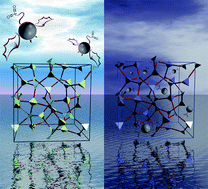
Editor-in-Chief, Journal of Materials Chemistry
Dongyuan Zhao was born in Shenyang, Liaoning Province in June 1963. He was a undergraduate student at Jilin University (1980-84), got his Master degree from Chemistry Department at Jilin University (1987), and a Ph.D.degree from Jilin University and Dalin Institute of Chemical Physics (1990). He began his academic career almost immediately as a lecturer in Chemical Engineering Department at the Shenyang Institute of Chemical Technology, and was promoted to an Associate Professor in 1992. In 1992-93, he was a visiting scholar in the Chemistry Department of University of Regina. After postdoctoral research at the Weizmann Institute of Science (with Prof. Daniella Goldfarb, 1993-94), University of Houston (with Prof. Larry Kevan, 1995-96), and University of California at Santa Barbara (with Prof. Galen D. Stucky, 1996-98), he joined the faculty of the Fudan University in Dec.1998, where he is now Professor in the Department of Chemistry. Dr. Zhao‘s research includes:
• Macro- and Microscopically Topological Construction of Highly Ordered Porous Materials
• Designed Synthesis, Assembly, Growth and Properties of Mesoporous Materials
• Structure and Synthesis Design of Novel Microporous Molecular Sieves
…………………………………………………• Rational Synthesis and Organization of Novel Patterned Nanoscale Materials.
His recent papers include:
Ligand exchange triggered controlled-release targeted drug delivery system based on core–shell superparamagnetic mesoporous microspheres capped with nanoparticles, J. Mater. Chem., 2012,22, 17677-17684
Self-assembly of monodispersed silica nano-spheres with a closed-pore mesostructure, J. Mater. Chem., 2012, 22, 11523-11528
Post-enrichment of nitrogen in soft-templated ordered mesoporous carbon materials for highly efficient phenol removal and CO2 capture, J. Mater. Chem., 2012, 22, 11379-11389
A hierarchical adsorption material by incorporating mesoporous carbon into macroporous chitosan membranes, J. Mater. Chem., 2012, 22, 11908-11911
Ordered mesoporous graphitized pyrolytic carbon materials: synthesis, graphitization, and electrochemical properties, J. Mater. Chem., 2012, 22, 8835-8845Dr. Zhao
 Deputy Editor-in-Chief, Journal of Materials Chemistry A
Deputy Editor-in-Chief, Journal of Materials Chemistry A
Kazuhito Hashimoto is currently a professor of chemistry at the University of Tokyo. After he received his BS and MS degrees from the University of Tokyo, he obtained a research position at the Institute for Molecular Science (Okazaki, Japan) in 1980. In 1989, he was invited as a lecturer in the Department Applied Chemistry at the University of Tokyo, where he was promoted to an associate professor in 1991. When he became a full professor in 1997, he opened his own laboratory at the Research Centre of Advanced Science & Technology. He also succeeded the chair of the Department of Applied Chemistry in 2003 and opened the laboratory at this department, too. His current research interests are development of functionalized materials for energy conversion and environmental purifications such as photocatalysts, polymer photovoltaic materials, electrochemical catalysts and microbial catalysts.
His recent papers include:
Efficient oxygen reduction by a Fe/Co/C/N nano-porous catalyst in neutral media, J. Mater. Chem. A, 2013, Advance Article, DOI: 10.1039/C2TA00392A
Poly(bis-2,6-diaminopyridinesulfoxide) as an active and stable electrocatalyst for oxygen reduction reaction, J. Mater. Chem., 2012, 22, 12263
Synthesis and application of poly(fluorene-alt-naphthalene diimide) as an n-type polymer for all-polymer solar cells, Chem. Commun., 2012,48, 5283-5285
. Deputy Editor-in-Chief, Journal of Materials Chemistry B
Deputy Editor-in-Chief, Journal of Materials Chemistry B
Christine E. Schmidt is the B.F. Goodrich Endowed Professor of Materials Engineering in the Departments of Biomedical Engineering and Chemical Engineering at the University of Texas at Austin. Dr. Schmidt received her B.S. degree in Chemical Engineering from the University of Texas at Austin in 1988 and her Ph.D. in Chemical Engineering from The University of Illinois at Urbana-Champaign in 1995. She conducted postdoctoral research at MIT as an NIH Postdoctoral Fellow, joining the UT Austin faculty in 1996. Dr. Schmidt will be moving to the University of Florida to be the J. Crayton Pruitt Family Professor & Department Chair for the J. Crayton Pruitt Family Department of Biomedical Engineering, effective January 1, 2013. Dr. Schmidt’s research is focused on developing new biomaterials and biomaterial composites (e.g., electronic polymer composites, natural material scaffolds and processed tissues) for neural engineering applications.
Her recent papers include:
Neuronal growth promoting sesquiterpene–neolignans; syntheses and biological studies, Org. Biomol. Chem., 2012,10, 383-393

Deputy Editor-in-Chief, Journal of Materials Chemistry C
Peter Skabara was born in Edinburgh in 1968. He was educated at Bolton School and gained his first degree from QMW, University of London. After completing his doctoral studies under the supervision of Professor Martin Bryce at the University of Durham (1994), he went on to work in the group of Professor Klaus Müllen at the Max-Planck Institute for Polymer Research in Mainz. In 2005 he joined the University of Strathclyde as the first WestCHEM Professor and is currently the 1870 Young Chair of Chemistry. His research activities involve the synthesis of electroactive molecules and macromolecules and their application in organic semiconductor devices.
His recent papers include:
BODIPY-based conjugated polymers for broadband light sensing and harvesting applications, J. Mater. Chem., 2012,22, 14119-14126
Electrochromic properties of a poly(dithienylfuran) derivative featuring a redox-active dithiin unit, Polym. Chem., 2012,3, 2277-2286
Incorporation of fused tetrathiafulvalene units in a DPP–terthiophene copolymer for air stable solution processable organic field effect transistors, J. Mater. Chem., 2012,22, 11310-11315
.Follow the latest journal news on Twitter @JMaterChem or go to our Facebook page.
To keep up-to-date with all the latest research, sign-up to our RSS feed or Table of contents alert.
Comments Off on Introducing the Journal of Materials Chemistry A, B and C Editor-in-Chief and Deputy Editors-in-Chief




























